
Are you throwing a housewarming party and don’t know what food to serve? Moving into a new home is exhilarating and deserves an epic get-together with your closest friends and family.
But after all the moving, unpacking, and decorating, the last thing on your mind is preparing different kinds of food. Luckily, you don’t have to spend hours in the kitchen. All you need are a few simple recipes to make delicious food your guests will love.
Here are our favorite simple and easy housewarming food ideas for your party that’ll wow your guests.
Fruit and Cheese Charcuterie Board
If you’re struggling with what to serve at housewarming party, a charcuterie board is an all-in-one solution. You can serve all kinds of finger foods without any cooking or baking.
A fruit and cheese board is a simple and delicious way to serve your guests a light snack that’ll keep them full. You can also add crackers, mini pastries, deli meats, honey, and dips.
Sweet and Savoury Muffins
Muffins, whether sweet or savoury, are the simplest housewarming snacks that’ll be an absolute hit at your party! They’re easy to make and you can play around with as many add-ons as you like.
With a single basic batter, you can make several different flavors and serve them on a beautiful platter so people can grab them to go as they mingle at your party.
Mini Sandwiches
If you’re throwing a housewarming party on a budget, a simple way to feed everyone is to make mini sandwiches. All you need is a few loaves of sliced bread, cucumbers, cheese, and olives. One big sandwich can make 4 mini bite-sized sandwiches that’ll be easy to make and easy to eat.
You can also make them vegetarian, vegan, gluten-free, or use different spreads to give each batch a different flavor. You can make the sandwiches a couple of days in advance, wrap them in plastic wrap, and put them in the fridge until they’re ready for serving with the rest of the party food ideas.
Easy Desserts
Desserts are an important part of your housewarming party menu. Whether it’s simple sugar cookies, pies, brownies, or cake, your guests will love having something sweet with a cup of coffee or tea.
Light and Fresh Cocktails
Once you sort out the housewarming party food ideas, it’s time to plan the drinks. The best beverages for your party are homemade cocktails, both alcoholic and non-alcoholic.
Depending on the season, you can make them fresh and light or full of warm spices and flavors. This is a great way to serve something fun and different for everyone without spending tons of money on expensive drinks.
These Housewarming Food Ideas Are the Perfect Choice for Your Party
Whether you’re throwing a party for your first-ever house purchase or you’re upgrading to a better home, these housewarming food ideas are simple and delicious. From finger foods and tasty snacks to mouth-watering desserts, your guests will talk about your creations long after the party.
Need more party planning ideas and recipes? Head over to our blog where we post about these topics and stay tuned for more of the latest trends in home and lifestyle.
 10% of U.S. households
10% of U.S. households




 Do you see yourself as an undiscovered Masterchef in the kitchen? You are probably one of the
Do you see yourself as an undiscovered Masterchef in the kitchen? You are probably one of the 
 Do you want to do your part in helping the environment?
Do you want to do your part in helping the environment?